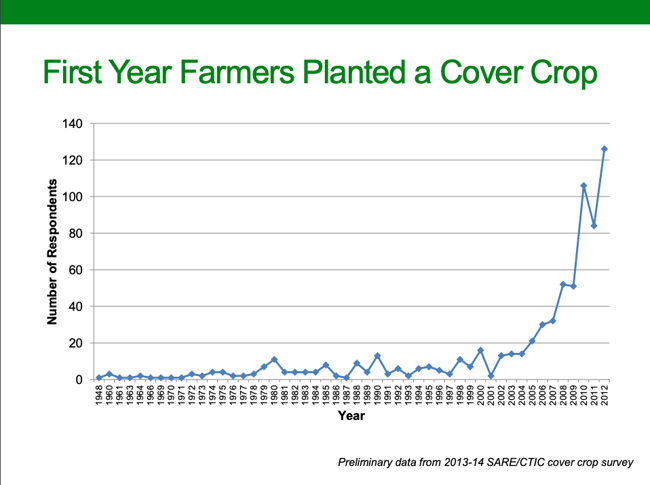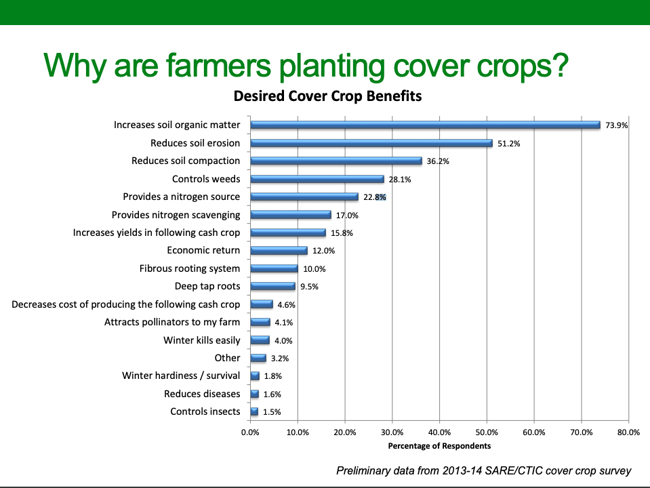-2.png?width=600&name=WWW.hOLGANIX.COM%20(5)-2.png)
As we look at the state of agriculture in 2020, there is a lot of exciting trends. From soil health, to farm profitability, hemp and broadband internet, many of these trends aren’t just creating a buzz in agriculture communities, but throughout America and have even been discussed at presidential debates. However, themes of improving farm profitability and environmental sustainability touches each trend.
Start reading the blog or click on the bookmarked links below to skip to the trend that interests you the most.
- Soil Health
- Regenerative Agriculture
- Hemp
- Water Use
- Indoor Vertical Farms
- Broadband Internet
- Small Farm Profitability
- Adding Additional Revenue Streams to the Farm
#1 Soil health
In 1937, U.S. President Franklin Roosevelt stated that “the nation that destroys its soil destroys itself.” At the time, soil health was an important weapon against soil erosion caused by the “dust bowl days” of the 1930s.
Today, soil health is trending for equally important reasons - the preservation of our soils is directly linked to America’s food security and could prove to be a weapon against climate change.
Soil Health and Food Security
The FAO, sited that sustainable soil management has the potential to produce up to 58% more food - and with world populations increase, it’s important to get as much crop out of our land as possible. Farmers understand that productive soils mean productive farms, and tools like soil amendments, cover crops, no-till, and others are becoming more popular in farming circles. Further, farmers see soil health as a way to preserve their land for future generations of farmers in their families.
Soil Health and Climate Change
Healthy soils help protect the planet from climate change. According to Columbia University’s Earth Institute, “Soil remove about 25% of the world’s fossil fuel emissions each year.” Governments and private enterprises are creating systems that provide the financial assistance needed to improve soil health on farms by providing grants, and sometimes paying farmers directly for the carbon their soils take from the atmosphere.
>> Learn how Holganix is helping farmers increase their soil health here
#2 Regenerative Agriculture
Regenerative agriculture describes farming and grazing practices that focus on regenerating topsoil, allowing farmers to maintain crop yields, improve water retention and plant uptake, increase farm profitability, and support biosequestration, among other benefits.
The backbone of regenerative agriculture is a focus on strengthening the health and vitality of farm soil.
While it’s not an old topic, the soil health trend has been giving regenerative agriculture a push to the limelight. Regenerative agriculture became increasingly a hot topic when General Mills pledge $2M to the “Nature Conservancy, Soil Health Institute, and Soil Health Partnership to support the development of tools and resources for farmers, landowners, and supply chain leaders to achieve widespread adoption of soil health practices.” But, their big goal is to advance regenerative agriculture on one million acres by 2030.
>>Learn more about the top 5 benefits of regenerative agriculture here
#3 Hemp
When the 2018 U.S. Farm Bill legalized hemp as a viable crop, there was a buzz of excitement in both the agriculture and consumer circles. Hemp acreage is a big opportunity for farmers and agtech companies that can navigate the lack of hemp infrastructure (how do you grow, sell and store hemp?).
In fact, hemp acres were an estimated 511,000 and hemp is expected to grow from $4.6B in 2019 to $26.6B in 2025.
It’s also a sustainable product when considering fiber production - requiring far less water and pesticide inputs than traditional crops like cotton.
>>Learn about how Holganix can help farmers grow hemp here
#4 Water Use
According to the USDA, “approximately 80% of the Nation’s consumptive water use and over 90% in many Western States.” Often a costly and in some state’s limited resources, farmers are looking for ways to use less water in order to maintain farm profitability.
Cost, coupled with sustainability practices and worries about drought, are pushing farmers to seek new tools and new farm practices to reduce water use.
How can farmers increase water efficiency?
According to the FAO, there are many ways farmers can look to increase water efficiency. Here are just a few of their recommendations:
- Reduce direct evaporation during irrigation by avoiding midday sprinkling. Minimize foliar interception by irrigating under-canopy rather than overhead sprinkling.
- Reduce evaporation from bare soil by mulching and by keeping the inter-row strips dry
- Reduce transpiration by weeds, keeping the inter-row strips dry and applying weed control measures where needed.
- Select crops most suitable and marketable for the region.
- Use optimal timing for plant and harvest.
- Use optimal tillage and voice excessive cultivation.
- Avoid progressive salinization by monitoring water table elevation.
- Irrigate at high frequency and in the exact amounts needed to prevent water deficits, taking account of weather conditions and crop growth stages.
- Practice soil conservation for long-term sustainability.
#5 Indoor Vertical Farming
Indoor vertical farms are expanding across the country. Despite the fact that AgFunder Network Partners estimates that it is “3 to 5 times more costly to grow in a vertical farm compared to conventional farming”, there are a lot of advantages to indoor vertical farming.
Yield Potential
With the ability to grow year-round, indoor vertical farms may have a higher yield potential on crops. According to Plenty - a silicon valley region vertical farm, “Plenty’s vertical farms grow crops up 20-foot towers, achieving yields up to 350 times that of the most productive outdoor equivalent.”
Savings in water, pesticides and food miles
Many indoor vertical farm outfits are setting up shop in urban areas. That’s great news since the USDA predicts that by 2050, “two out of every three people are expected to live in urban areas. Generally, fresh produce grown in vertical farms travel only a few miles to reach grocery store shelves compared to conventional produce, which can travel thousands of miles.”
And, because crops are grown in controlled environments, fewer pesticides and less water are required than conventional produce.
#6 Broadband Internet
An increasingly hot topic in the 2021 Presidential Debate, providing a more robust broadband internet connection to rural America will have dramatic effects on rural farmers. According to officials at the FCC, over 24,000,000 Americans lack access to broadband internet.
Farmers that do have access to broadband are discovering new ways to put “their use of broadband and other forms of technology to work for them.” Farmers now have technology and apps that allow them to monitor crops each day.
#7 Small Farm Income Expected to Grow By 9.3%
Small farm operations consist of less than half of all farms in the U.S. But experts are saying small farms will “experience growth and income of about 9.3% compared to the previous year.” The bump in income will help farmers pay their bills and invest in new technology to improve the health of their farms.
#8 Cover Crops
According to the 2017 census cover crop plantings grew by 50% to 15.4 million acres in the U.S. And, in eight states it grew by more than 100% from 2012 to 2017.
Survey research by SARE - the Sustainable Agriculture Research & Education department, shows that farmers that planted a cover crop for the first time have also been increasing since 2005.

Why Are Farmers Using Cover Crops?
There are a lot of reasons why farmers are opting to use cover crops. According to a SARE cover crop survey, 74% of respondents say they use cover crops to increase soil organic matter. Additionally, farmers are looking to reduce soil erosion, soil compaction, and control weeds.

Photo credit for above two charts: http://css.wsu.edu/oilseeds//files/2015/02/MyersCoverCrops2015OSDS.pdf
#9 Additional Revenue Streams
Farmers are looking for different ways to increase their farm’s profitability by representing other products or by providing other services. Whether a farmer is looking to sell seed, insurance, or make extra income spraying a neighbor’s field, there are a lot of ways for farmers to add an additional revenue stream to their farm.
At Holganix we have teamed up with the Van Trump Report to partner with entrepreneurial, influential farmers that are looking to add an additional revenue stream to their farmers by educating and connecting us to other farmers in their region.
Our goal is to empower farmers to increase revenue on their farms and Holganix farm dealers earn on every acre placed!
How can Holganix help farmers increase their farm profitability?
We generate a return for farmer dealers in 4 different ways:
- By partnering as a dealer, farmers add an additional revenue stream to their farm
- By increasing crop yield, typically a 3-5x ROI using Holganix’s Bio 800+ Agriculture technology
- By building rich soils that improve the long-term productivity of your farm for future generations using Holganix Bio 800+ Agriculture
- By receiving Holganix Bio 800+ Agriculture at wholesale to use on your farm
>>Learn more about becoming a Holganix farm dealer here
 |
January 30, 2020
|
6:00 PM
|
January 30, 2020
|
6:00 PM
-2.jpg)
-1.jpg)
-1.jpg)
-1.jpg)
.jpg)

-2.jpg)
-1.jpg)
-1.jpg)
-1.jpg)
.jpg)




-2.png?width=600&name=WWW.hOLGANIX.COM%20(5)-2.png)


.webp)
-1%20(1).webp)
-831535-2.webp)



.png)
.jpg)
.png)